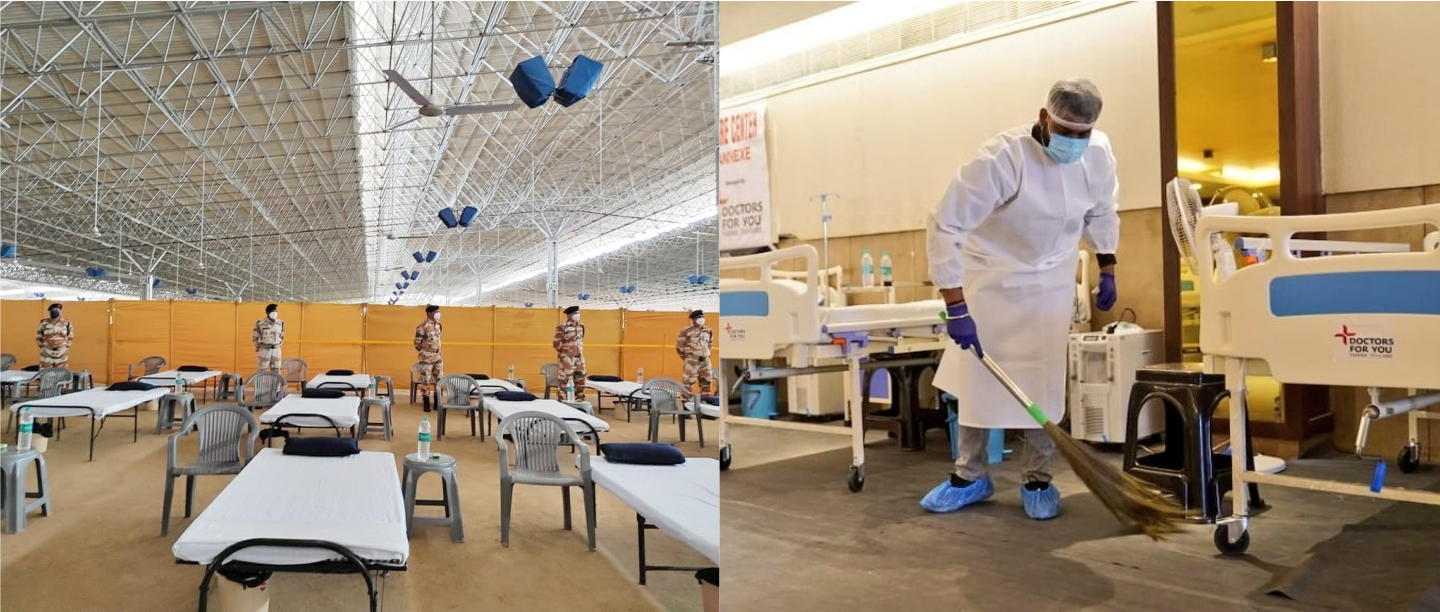
The novel coronavirus is spreading at an unprecedented rate in India. While several countries across the world have managed to flatten the curve, the virus is yet to reach its peak in India. With new record-high cases every day, India has been scrambling to strengthen its healthcare infrastructure.
The capital of New Delhi is the second worst-hit city in the country at present, with over 70,000 confirmed cases. To make space for incoming patients, the government has converted various facilities into COVID-19 quarantine centres. The government is seeking to further increase the number of beds available for patients by setting up makeshift hospitals in 40 hotels and 77 banquet halls. The idea is to add 15,800 beds for sick patients. Five hundred converted railway coaches will add another 8,000 beds for the city’s COVID-19 patients.
Also Read: COVID-19 Got You Stressed? Study Suggests You Might Be At High Risk Of Severe Infection
Recently, the government decided to take over the campus of Radha Soami Satsang Beas, a religious institute in Delhi’s Chattarpur area, and converted it into the country’s largest coronavirus facility. Spread over 70 acres, roughly the size of 22 football fields, the facility will have 10,000 beds and will be functional from July 1.
Curious to know what the country’s largest facility would look like? Here’s what you can expect.
No Relatives Allowed
If you have tested positive for coronavirus and want to transfer to a quarantine facility, you should be prepared to stay there alone. Relatives can accompany you to the centre, but they won’t be allowed beyond the facility gates. Only patients are allowed to enter the facility. “We would prefer if they can send the patients here in ambulances, but even if they bring them themselves, they’ll have to handover the patients to us at the gates and leave,” BM Mishra, district magistrate (south) told a national daily.
To handle the admission and discharge of patients, the authorities will use an e-hospital app that is being developed by the National Informatics Centre, said the DM. A team will work on 400 computers at the centre, he said.
Facilities At The Centre
If you’re looking for private rooms at luxury, this isn’t the centre for you. However, you will find all the basic amenities required to be able to comfortably spend a few days in quarantine. Every patient will have a bed, a stool, a chair, a small plastic cupboard, a dustbin and utensils, and will be given a toiletry kit. The beds will either be the foldable iron cots, or ones manufactured using cardboard.
If you’re concerned about boredom, fret not. Patients are allowed to carry electronics like cellphones and laptops. “Individual phone and laptop charging facility will be available for each bed. Patients can also bring their laptops, but for any video or audio application, they will have to use headphones,” said the DM.
Wondering about food? It will be simple, but hygienic and nutritious, served to the patients by volunteers who will roll them on trolleys along the rows of beds. “The Satsang is capable of cooking food for three lakh people a day. So, that will not be a problem,” said the DM.
Also Read: COVID-19 Testing Set To Get Accessible: India Launches First Mobile I-Lab For Remote Areas
Toilets & Water Supply
At present, there are 600-odd toilets at the centre with 70 portable toilets. This also includes three special ones for physically challenged people, stationed outside. The authorities are trying to arrange for more toilets, as 600 won’t be enough for 10,000 people. “We will bring more portable toilets. The aim is to have one toilet for every 10 patients at least,” said the DM.
What about cleanliness? According to Sanjeev Tiwari, the operations head of YLDA India Pvt Ltd, the firm hired to set up portable toilets, each toilet can be used about 200 times before the waste needs to be taken away. “Suction vehicles will be ready to take away the waste and make the toilets usable immediately. The toilets will be cleaned twice a day and once at night,” he said.
You will not be expected to bring your own water–the government has installed hydrants for the underground reservoir facility that has a capacity of 1.7 lakh litres, for uninterrupted water supply. “The water supply capacity has been augmented. The Delhi Jal Board (DJB) will check samples five times a day to ensure that the quality of water is good,” said Raghav Chadha, the DJB’s vice-chairman who visited the place on Wednesday.
Separate Sections For Patients, Healthcare Workers & Staff
To ensure minimal interaction between the patients and other staff at the facility, the centre will be divided into three sections keeping in mind the safety of the patients as well as the workers.
Sonalika Jiwani, IAS officer and sub-divisional (SDM) of Mehrauli, said the facility is divided into three sections: the largest for the patients, another for nurses and doctors, and the third will serve as the command section. “For patients, there will be 116 sections of 88 beds each. In the first phase, we’ll have 2,000 beds ready by Thursday,” she said.
The site was serviced by the fans hanging from long poles, with one fan on an average for every three beds. However, keeping the hot weather in mind, dozens of large air-conditioners have already been installed, and even as more were on their way.
On Tuesday, home minister Amit Shah had tweeted that a large part of the facility would be operational by Friday and manned by the Indo-Tibetan Border Police (ITBP). While the government is certainly trying its best to meet the infrastructural requirements for the city, we hope they will be enough for the rapidly spiking number of cases.
Featured Image: Twitter